NCERT Exemplar Class 9 Maths Chapter 6 Lines And Angles
NCERT Exemplar Class 9 Maths Chapter Exercise 6.1
Write the correct answer in each of the following:
Question 1.
In the given figure, if AB || CD || EF, PQ || RS, ∠RQD = 25° and ∠CQP = 60°, then ∠QRS is equal to
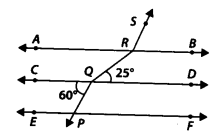
(A) 85°
(B) 135°
(C) 145°
(D) 110°
Solution:
(C): Produced PQ to X which intersect AB at Y.
PQ || RS ⇒ PX || RS
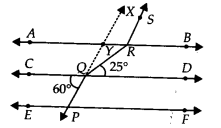
∵ AB || CD and PX is transversal
∠CQP + ∠AYX = 180° [Co-exterior angles]
⇒ 60° + ∠AYX = 180°
⇒ ∠AYX = 180° – 60°
⇒ ∠AYX = 120°
∵ PX || RS and AB is transversal
∠YRS = ∠AYX [Corresponding angles]
⇒ ∠YRS = 120° …(i)
and AB || CD and RQ is transversal
∠YRQ = ∠RQD [Alternate interior angles]
⇒ ∠YRQ = 25° …(ii)
Now, ∠SRQ = ∠SRY + ∠YRQ
⇒ ∠SRQ = 120° + 25° [From (i) and (ii)]
⇒ ∠SRQ = 145°
Question 2.
If one angle of a triangle is equal to the sum of the other two angles, then the triangle is
(A) an isosceles triangle
(B) an obtuse triangle
(C) an equilateral triangle
(D) a right triangle
Solution:
(D): Let the angles of a ∆ABC be ∠A, ∠B and ∠C.
We have given, ∠A = ∠B + ∠C …(i)
In ∆ABC, ∠A + ∠B + ∠C = 180° …(ii)
[Angle sum property of a triangle]
From (i) and (ii),
∠A + ∠A = 180°
⇒ 2∠A = 180°
⇒ ∠A = 90°
Hence, the triangle is a right triangle.
Question 3.
An exterior angle of a triangle is 105° and its two interior opposite angles are equal. Each of these equal angles is

Solution:
(B) : Let one of the interior opposite angle of a triangle be x.
∵ Exterior angle
= sum of two opposite interior angles
∴ x + x = 105° [ ∵ Exterior angle = 105° and two interior opposite angles are equal]
⇒ 2x = 105° ⇒ x = \(52 \frac{1}{2}\)°.
Thus, each of the required angles of a triangle \(52 \frac{1}{2}\)°.
Question 4.
The angles of a triangle are in the ratio 5 : 3 : 7. The triangle is
(A) an acute angled triangle
(B) an obtuse angled triangle
(C) a right triangle
(D) an isosceles triangle
Solution:
(A): We have given, the ratio of angles of a triangle is 5 : 3 : 7.
Let angles of a triangle be ∠A, ∠B and ∠C, where ∠A = 5x, ∠B = 3x and ∠C = 7x Now in ∆ABC, ∠A + ∠B + ∠C = 180°
[Angle sum property of a triangle]
∴ 5x + 3x + 7x = 180°
⇒ 15x = 180°
So, ∠A = 5 × 12° = 60°, ∠B = 3 × 12° = 36° and ∠C = 7 × 12° = 84°
∵ All angles are less than 90°, hence the triangle is an acute angled triangle.
Question 5.
If one of the angles of a triangle is 130°, then the angle between the bisectors of the other two angles can be
(A) 50°
(B) 65°
(C) 145°
(D) 155°
Solution:
(D) : Let angles of a triangle be ∠A, ∠B and ∠C, where ∠A = 130°
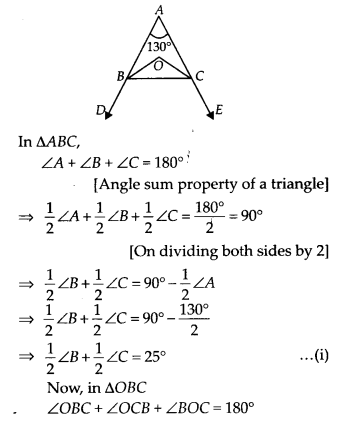
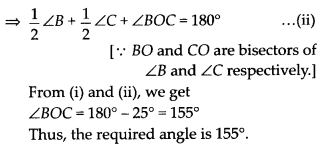
Question 6.
In the given figure, POQ is a line. The value of x is
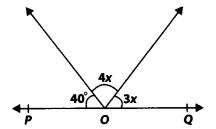
(A) 20°
(B) 25°
(C) 30°
(D) 35°
Solution:
(A) :
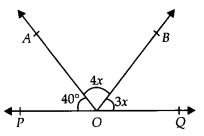
Since, POQ is a line segment.
∴ ∠POQ = 180°
⇒ ∠POA + ∠AOB + ∠Solution:Q = 180°
⇒ 40° + 4x + 3x = 180°
⇒ 7x = 180° – 40° ⇒ 7x = 140° ⇒ x = 20°
Question 7.
In the given figure, if OP || RS, ∠OPQ = 110° and ∠QRS = 130°, then ∠PQR is equal to

(A) 40°
(B) 50°
(C) 60°
(D) 70°
Solution:
(C) : Draw a line EF parallel to RS through point Q

∵ OP || RS [Given]
⇒ EF || RS [Construction]
∴ OP || EF and PQ is a transversal
⇒ ∠OPQ = ∠PQF [Alternate interior angles]
⇒ ∠PQF = 110° [ ∵ ∠OPQ = 110°]
⇒ ∠PQR + ∠RQF = 110° … (i)
Now, RS || EF and RQ is a transversal
⇒ ∠QRS + ∠RQF = 180° [Co-interior angles]
⇒ 130° + ∠RQF = 180°
⇒ ∠RQF = 180° – 130° = 50°
Now from (i), we have
⇒ ∠PQR + 50° = 110°
⇒ ∠PQR = 110° – 50°
⇒ ∠PQR = 60°
Question 8.
Angles of a triangle are in the ratio 2 : 4 : 3. The smallest angle of the triangle is
(A) 60°
(B) 40°
(C) 80°
(D) 20°
Solution:
(B) : We have given, the ratio of angles of a triangle is 2 : 4 : 3.
Let the angles of a triangle be ∠A, ∠B and ∠C, where ∠A = 2x, ∠B = 4x and ∠C = 3x
Now in ∆ ABC, ∠A + ∠B + ∠C = 180°
[Angle sum property of a triangle]
⇒ 2x + 4x + 3x = 180°
⇒ 9x = 180° ⇒ x = 20°
∠A = 2 × 20° = 40°, ∠B = 4 × 20° = 80° and ∠C = 3 × 20° = 60°
Thus, the smallest angle of the triangle is 40°.
NCERT Exemplar Class 9 Maths Chapter Exercise 6.2
Question 1.
For what value of x + y in the given figure will ABC be a line? Justify your answer.
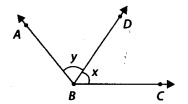
Solution:
For ABC to be a line, the sum of the two adjacent angles must be 180° i.e., x + y = 180°.
Question 2.
Can a triangle have all angles less than 60°? Give reason for your answer.
Solution:
No, because if all angles will be less than 60°, then their sum will not be equal to 180° and that will not be a triangle.
Question 3.
Can a triangle have two obtuse angles? Give reason for your answer.
Solution:
No, because if two angles will be more than 90°, then the sum of angles will not be equal to 180°.
Question 4.
How many triangles can be drawn having its angles as 45°, 64° and 72°? Given reason for your answer.
Solution:
The sum of given angles = 45° + 64° + 72° = 181° * 180°.
Thus the sum of all three angles is not equal to 180°. So, no triangle can be drawn with the given angles.
Question 5.
How many triangles can be drawn having its angles as 53°, 64° and 63°? Give reason for your answer.
Solution:
Since, the sum of given angles = 53°+ 64° + 63° = 180°
Thus, we see that the sum of all interior angles of a triangle is 180°. So, we can draw many triangles of the given angles with different sides. Hence, infinitely many triangles can be drawn.
Question 6.
In the given figure, find the value of x for which the lines l and m are parallel.
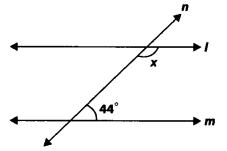
Solution:
We have given, l || m and a transversal line n,
∴ x + 44° = 180° [Co-interior angles]
⇒ x = 180° – 44° ⇒ x = 136°
Question 7.
Two adjacent angles are equal. Is it necessary that each of these angles will lie a right angle? Justify your answer.
Solution:
No, because each of the two adjacent angles will be right angles only if they will form a linear pair.
Question 8.
If one of the angles formed by two intersecting lines is a right angle, what can you say about the other three angles? Give reason for your answer.
Solution:
Let two lines AB and CD intersect each other at a right angle.
Let ∠AOC = 90°
∠AOC + ∠AOD = 180° [Linear pair]
⇒ ∠AOD = 180° – 90° = 90°
Now, ∠COA = ∠DOB = 90°
[Vertically opposite angles]
and ∠AOD = ∠COB = 90°
[Vertically opposite angles]
Hence, each of the other three angles are right angles.
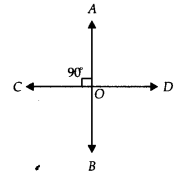
Question 9.
In the given figure, which of the two lines are parallel and why?
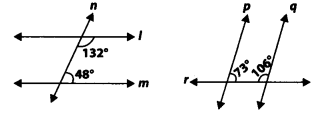
Solution:
Left side figure shows the sum of two interior angles = 132° + 48° = 180° because the sum of two interior angles on the same side of a transversal line n is 180°, thus l ||m.
Right side figure shows the sum of two interior angles = 73° + 106° = 179° ≠ 180° because the sum of two interior angles on the same side of a transversal line r is not equal to 180°, thus p is not parallel to q.
Question 10.
Two lines l and m are perpendicular to the same line n. Are l and m perpendicular to each other? Give reason for your answer.
Solution:
No
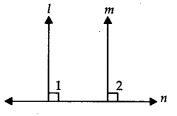
Given that the lines l and m are perpendicular to the line n.
∴ ∠1 = ∠2 = 90°
This shows that the corresponding angles are equal.
Thus, l || m.
NCERT Exemplar Class 9 Maths Chapter Exercise 6.3
Question 1.
In the given figure, OD is the bisector of ∠AOC, OE is the bisector of ∠BOC and OD ⊥ OE. Show that the points A, O and B are collinear.
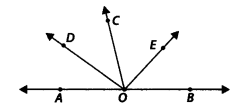
Solution:
Since, OD and OE bisects ∠AOC and ∠BOC, respectively.
∴ ∠AOC = 2∠DOC …(i)
and ∠COB = 2 ∠COE …(ii)
On adding (i) and (ii), we get
∠AOC + ∠COB = 2 ∠DOC + 2 ∠COE
⇒ ∠AOC + ∠COB = 2 (∠DOC + ∠COE)
⇒ ∠AOC + ∠COB = 2 ∠DOE
⇒ ∠AOC + ∠COB = 2 × 90° [∵ OD ⊥ OE]
⇒ ∠AOC + ∠COB = 180°
As, adjacent angles ∠AOC and ∠COB form a linear pair.
∴ AOB is a straight line.
Thus, points A, O and B are collinear.
Question 2.
In the given figure, ∠1 = 60° and ∠6 = 120°. Show that the lines m and n are parallel.
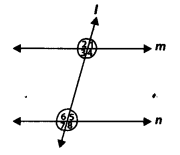
Solution:
We have ∠1 = 60° and ∠6 = 120°
∠1 = ∠3 = 60° [Vertically opposite angles]
Now, ∠3 + ∠6 = 60° + 120°
⇒ ∠3 + ∠6 = 180°
Since the above shows that the sum of two interior angles on same side of a transversal line l is 180°, thus m || n
Question 3.
AP and BQ are the bisectors of the two alternate interior angles formed by the intersection of a transversal t with parallel lines l and m (in the given figure). Show that AP || BQ.
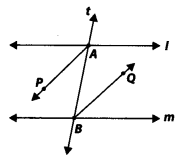
Solution:
Since, l || m and t is a transversal line.
∴ ∠EAB = ∠ABH [Alternate interior angles]
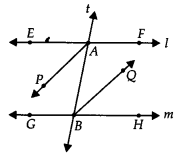
[On dividing Solution:th sides by 2]
⇒ ∠PAB = ∠ABQ
[∵ AP and BQ are the bisectors of ∠EAB and ∠ABH] Since, ∠PAB and ∠ABQ are alternate interior angles formed by lines AP and BQ and transversal AB. Thus, AP || BQ.
Question 4.
If in the given figure, bisectors AP and BQ of the alternate interior angles are parallel, then show that l || m.
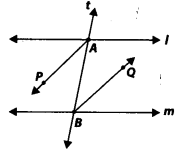
Solution:
Since, AP || BQ and t is a transversal, therefore, ∠PAB = ∠ABQ
[Alternate interior angles]
⇒ 2 ∠PAB = 2 ∠ABQ
[On multiplying both sides by 2]
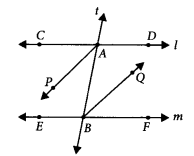
⇒ ∠CAB = ∠ABF [ ∵ AP and BQ are the bisectors of ∠CAB and ∠ABF]
Since, ∠CAB and ∠ABF are alternate interior angles formed by lines l and m and transversal t. Thus, l || m.
Question 5.
In given figure, BA || ED and BC || EF. Show that ∠ABC = ∠DEF.
[Hint: Produce DE to intersect BC at P (say)].
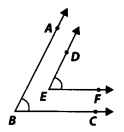
Solution:
Let us produce DE, which meets BC at P.
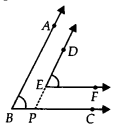
Since BA || ED ⇒ BA || DP
∴ ∠ABP = ∠EPC [Corresponding angles]
or ∠ABC = ∠EPC …(i)
Again, BC || EF or PC || EF
∴ ∠DEF = ∠EPC …(ii)
[Corresponding angles] From (i) and (ii), we get
∠ABC = ∠DEF
Question 6.
In the given figure, BA || ED and BC || EF. Show that ∠ABC + ∠DEF = 180°.
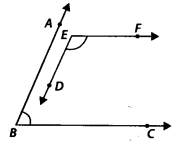
Solution:
Let us produce FE, which meets AB at P.
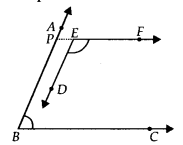
BC || EF ⇒ BC || PF
∴ ∠EPB + ∠PBC = 180° …(i)
[Co-interior angles]
Now, AB || ED and PF is a transversal.
∴ ∠EPB = ∠DEF …(ii)
[Corresponding angles]
From (i) and (ii), we get
∠DEF + ∠PBC = 180°
⇒ ∠ABC + ∠DEF = 180° [ ∵ ∠PBC = ∠ABC]
Question 7.
In the given figure, DE || QR and AP and BP are bisectors of ∠EAB and ∠RBA, respectively. Find ∠APB.
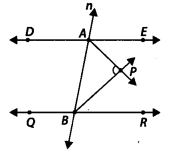
Solution:
DE || QR and AB is a transversal
∴ ∠EAB + ∠RBA = 180° (Co-interior angles)
![]()
[On dividing both sides by 2]
∵ AP and BP are the bisectors of ∠EAB and ∠RBA, respectively.
![]()
Using these in (i), we have
⇒ ∠BAP + ∠ABP = 90° …(ii)
In ∆APB, ∠BAP + ∠ABP + ∠APB = 180°
[Angle sum property of a triangle]
⇒ 90° + ∠APB = 180° [From (ii)]
⇒ ∠APB = 90°
Question 8.
The angles of a triangle are in the ratio 2 : 3 : 4. Find the angles of the triangle.
Solution:
Let the angles of a triangle be 2x, 3x and 4x. Since sum of all angles of a triangle is 180°.
∴ 2x + 3x + 4x = 180°
![]()
∴ The required three angles are 2 × 20° = 40°, 3 × 20° = 60° and 4 × 20° = 80°.
Question 9.
A triangle ABC is right angled at A. L is a point on BC such that AL ⊥ BC. Prove that ∠BAL = ∠ACB.
Solution:
In ∆ABC and ∆ALB,
∠BAC = ∠ALB [Each 90°]…(i)
and ∠ABC = ∠ABL [Common angle]…(ii)
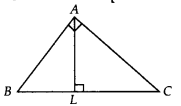
On adding (i) and (ii), we get
∠BAC + ∠ABC = ∠ALB + ∠ABL …(iii)
Again, in ∆ABC,
∠BAC + ∠ACB + ∠ABC = 180°
[Angle sum property of a triangle]
= ∠BAC + ∠ABC = 180° – ∠ACB …(iv)
In ∆ABE,
∠ABL + ∠ALB + ∠BAL = 180°
[Angle sum property of a triangle]
⇒ ∠ABL + ∠ALB = 180° – ∠BAL …(v)
On substituting the values from (iv) and (v) in (iii), we get
180° – ∠ACB = 180° – ∠BAL
⇒ ∠ACB = ∠BAL
Question 10.
Two lines are respectively perpendicular to two parallel lines. Show that they are parallel to each other.
Solution:
Let two lines m and n are parallel and p and q are respectively perpendicular to m and n.
Since, p ⊥ m ⇒ ∠1 = 90° …(i)
Also, q ⊥ m ⇒ ∠2 = 90° …(ii)
[Since, m || n and q ⊥ n ⇒ q ⊥ m]
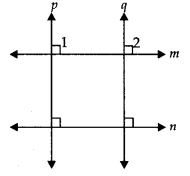
From (i) and (ii), we have
Z1 = Z2 = 90°
As p and q are two lines and m is transversal. Also corresponding angles ∠1 and ∠2 are equal.
Thus, p || q.
NCERT Exemplar Class 9 Maths Chapter Exercise 6.4
Question 1.
If two lines intersect, prove that the vertically opposite angles are equal.
Solution:
Let the two lines AB and CD intersect at a point O.
Since, ray OA stands on line CD.
∴ ∠AOC + ∠AOD = 180° [Linear pair]…(i)
Since, ray OD stands on line AB.
∠AOD + ∠AOD = 180° [Linear pair] …(ii)
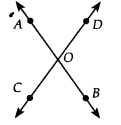
From (i) and (ii), we get
∠AOC + ∠AOD = ∠AOD + ∠BOD
⇒ ∠AOC + ∠BOD
So, vertically opposite angles ∠AOC and ∠BOD are equal.
Also, ray OB stands on line CD.
∴ ∠DOB + ∠BOC = 180° [Linear pair] …(iii)
From (ii) and (iii), we get
∠AOD + ∠BOD = ∠DOB + ∠BOC
⇒ ∠AOD = ∠BOC
Thus, vertically opposite angles ∠AOD and ∠BOC are equal.
Question 2.
Bisectors of interior ∠B and exterior ∠ACD of a ∆ABC intersect at the point T. Prove that
∠BTC= \(\frac{1}{2}\)∠BAC.
Solution:
In ∆ABC, produce BC to D and the bisectors of ∠ABC and ∠ACD meet at point T.
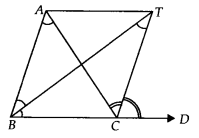
In ∆ABC,
∠ACD = ∠ABC + ∠CAB
[Exterior angle property of a triangle]
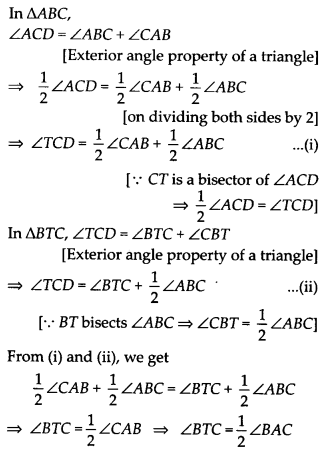
Question 3.
A transversal intersects two parallel lines. Prove that the bisectors of any pair of corresponding angles so formed are parallel.
Solution:
Let AB and CD are two parallel lines and intersected by a transversal GH at P and Q, respectively. Also, let EP and FQ are the bisectors of corresponding angles ∠APG and ∠CQP, respectively.
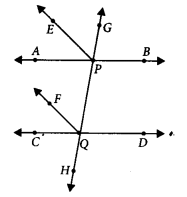
Since AB || CD
⇒ ∠APG = ∠CQP [Corresponding angles]
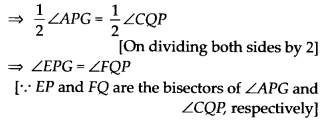
[On dividing both sides by 2]
⇒ ∠EPG = ∠FQP
[∵ EP and FQ are the bisectors of ∠APG and ∠CQP, respectively]
As, these are the corresponding angles made by the lines EP and FQ and transversal line GH.
EP || FQ
Question 4.
Prove that through a given point, we can draw only one perpendicular to a given line.
[Hint: Use proof by contradiction].
Solution:
Let a line l and a point P.

Also let m and n are two lines passing through P and perpendicular to l.
In ∆APB,
∠A + ∠P + ∠B = 180°
[Angle sum property of a triangle]
⇒ 90° + ∠P + 90° = 180°
⇒ ∠P = 180°- 180°
⇒ ∠P = 0°
∴ Lines n and m coincide.
Thus, only one perpendicular line can be drawn through a given point on a given line.
Question 5.
Prove that two lines that are respectively perpendicular to two intersecting lines intersect each other.
[Hint: Use proof by contradiction].
Solution:
Let lines l and m are two intersecting lines. Again, let n and p be another two lines which are perpendicular to m and l respectively.
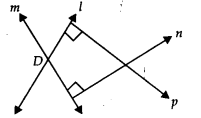
Let us assume that lines n and p are not intersecting, that means they are parallel to each other i.e., n||p …(i)
Since, lines n and p are perpendicular to m and l, respectively.
But from (i), n || p ⇒ l || m, which shows a contradiction.
So, our assumption was wrong.
Thus lines n and p intersect at a point.
Question 6.
Prove that a triangle must have atleast two acute angles.
Solution:
Let ∆ABC is a triangle.
We know that, the sum of all three angles is 180°.
∴ ∠A + ∠B + ∠C = 180° …(i)
Let us consider the following cases.
Case I: When two angles are 90°.
Suppose two angles ∠B = 90° and ∠C = 90°
So from (i), we get
∠A + 90° + 90° = 180°
⇒ ∠A = 180° -180° = 0
Thus, no triangle is possible.
Case II: When two angles are obtuse.
Suppose ∠B and ∠C are obtuse angles.
From (i), we get ∠A = 180° – (∠B + ∠C)
= 180° – (greater than 180°)
[ ∵ ∠B + ∠C = more than 90° + more than 90°]
⇒ ∠A = negative angle, which is not possible,
Thus, no triangle is possible.
Case III: When one angle is 90°.
Suppose ∠B = 90°.
From (i), ∠A + ∠B + ∠C= 180°
⇒ ∠A + ∠C = 180° – 90° = 90°
So, sum of other two angles are 90°, Hence, both angles are acute.
Case IV: When two angles are acute, then sum of two angles is less than 180°, so that the third angle may be acute or obtuse.
Thus, a triangle must have atleast two acute angles.
Question 7.
In the given figure, ∠Q > ∠R, PA is the bisector of ∠QPR and PM ⊥ QR. Prove that ∠APM = \(\frac{1}{2}\)(∠Q – ∠R).
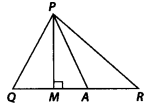
Solution:
Since, PA is the bisector of ∠QPR.
∴ ∠ QPA = ∠ APR
In ∆PQM, ∠PQM + ∠PMQ + ∠QPM = 180°
[Angle sum property of a triangle]
⇒ ∠PQM + 90° + ∠QPM = 180°
[ ∵ PM ⊥ QR
⇒ ∠PMQ = 90°]
⇒ ∠PQM = 90° – ∠QPM …(ii)
In ∆PMR,
∠PMR + ∠PRM + ∠RPM = 180°
[Angle sum property of a triangle]
⇒ 90° + ∠PRM + ∠RPM = 180°
[∵ PM ⊥ QR ⇒ ∠PMR = 90°]
⇒ ∠PRM = 180° – 90° – ∠RPM
⇒ ∠PRM = 90° – ∠RPM …(iii)
On subtracting (iii) from (ii), we get
∠Q – ∠R = (90° – ∠QPM) – (90° – ∠RPM)
[ ∵ ∠PQM = ∠Q and ∠PRM = ∠R]
⇒ ∠Q – ∠R = ∠RPM – ∠QPM
⇒ ∠Q – ∠R = [∠RPA + ∠APM] -[∠QPA – ∠APM]
⇒ ∠Q – ∠R = ∠RPA + ∠APM – ∠QPA + ∠APM
⇒ ∠Q – ∠R = 2∠APM [By using (i)]
∠APM = \(\frac{1}{2}\) (∠Q – ∠R)